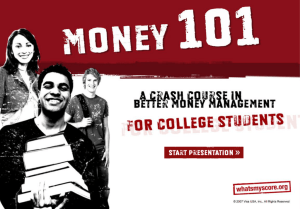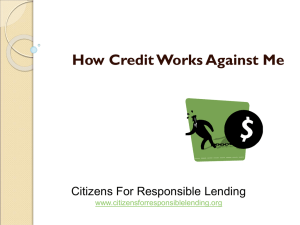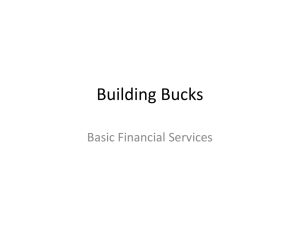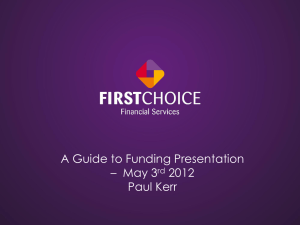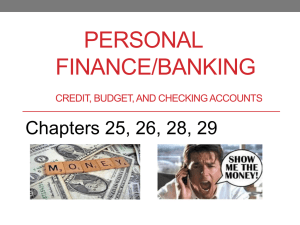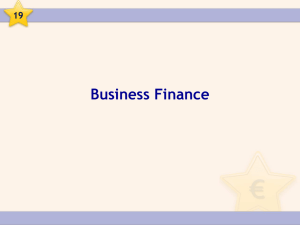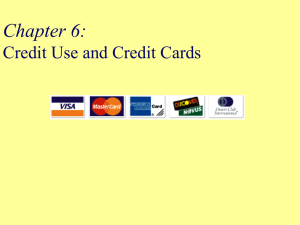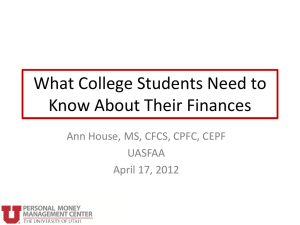PFL_6-8-2014-3x
advertisement
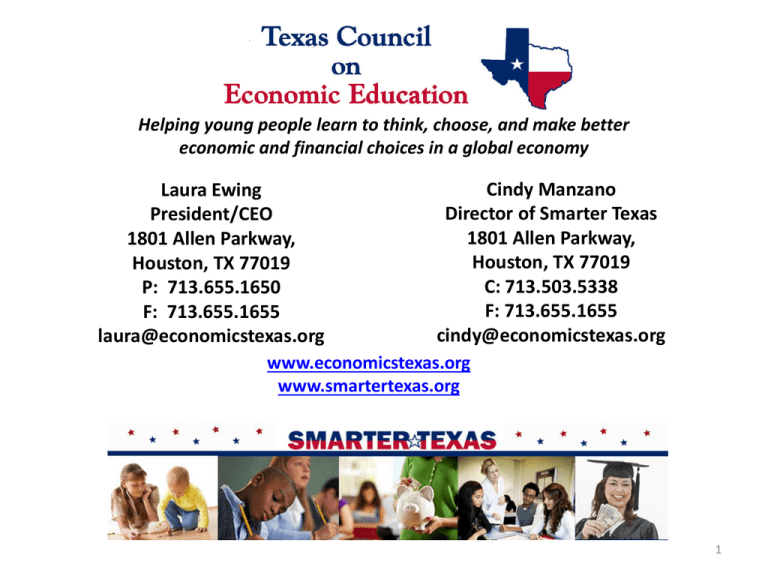
Helping young people learn to think, choose, and make better economic and financial choices in a global economy Laura Ewing President/CEO 1801 Allen Parkway, Houston, TX 77019 P: 713.655.1650 F: 713.655.1655 laura@economicstexas.org Cindy Manzano Director of Smarter Texas 1801 Allen Parkway, Houston, TX 77019 C: 713.503.5338 F: 713.655.1655 cindy@economicstexas.org www.economicstexas.org www.smartertexas.org 1 Financial Fitness For Life – Spiraled Curriculum • Kindergarten – Grade 2 • Grades 3 – 5 • Grades 6 – 8 • Grades 9 – 12 2 3 • Free lessons for grades 4-8 – Full 5E lesson for each PFL TEKS – Lessons for grades 4-6 funded by – Lessons for grades 7-8 funded by – www.smartertexas.org under Resource tab 4 The TCEE programs are made possible by the following TCEE partners. John Anderson Trout Foundation copyDR. EnviroChem Services, Inc. Less B. Fox RBC Wealth Management Student Loan Debt – Average student loan debt • 2010 – $24,000 • 2011 – $25,250 • 2012 –$33,000 – Total student loan debt: • 2010 – 850 billion dollars • 2012 – over 1 trillion dollars 6 7 What is Personal Financial Literacy? Why do we need it? TCEE Grade 6 Lesson 1 Best Payment Option: Debit or Credit 8 9 The student is expected to: Math 6.14B distinguish between debit cards and credit cards 10 TCEE Grade 6 Lesson 2 Checks and Balances 11 12 The student is expected to: Math 6.14A compare the features and costs of a checking account and a debit card offered by different local financial institutions Math 6.14C balance a check register that includes deposits, withdrawals, and transfers 13 Deposit or Withdrawal Deposit Withdrawal 14 Deposit or Withdrawal in Deposit + out - Withdrawal 15 Identify the Bank Transaction Debbie paid her rent by writing a $400 check to her landlord. Money is automatically transferred into Debbie’s checking account for earnings from her job. Debbie went shopping for some treats for her dog, Bruno, and a new leash at Pet City. When she checked out, she entered her personal identification number (PIN) at the register and paid with the debit card. Debbie wanted cash to pay for the cost of a movie ticket and popcorn. She stopped at an ATM machine, entered a code and took cash out of the machine. Debbie received two checks for her birthday. She went to her bank, filled out a slip and gave the check to the bank teller. 16 Vocabulary Transaction: Any activity with money such as a deposit, a withdrawal, or a transfer. ATM Surcharge: An Automatic Teller Machine (ATM) fee financial institutions charge for withdrawing money. Insufficient Funds: This term describes the circumstance of not having enough money in a checking account to make a payment or to withdraw money. Overdraft fee: This is a fee charged by the financial institution for making a purchase against your checking account in which there is not enough money in the account to cover the payment. 17 18 Overdraft protection example: Debbie had $395 in her checking account when the $400 rent check was processed. $395 - $400 = -$5 -$5 - $25 = -$30 Why is this feature called overdraft protection? 19 20 What is the best option? 21 Activity 6.2-1 SafeMoney Bank Terms: Monthly service fee of $15 is applied if the account falls below $100 Monthly debit card fee of $1 An overdraft fee of $20 for each overdraft. ATM cash withdrawals will be denied if the account has insufficient funds. ATM Surcharge for Local Financial Institutions: MY Credit Union: $3.00 Wise Bank: $2.00 22 23 24 My Credit Union Game Rules Shuffle game cards and place them face down in one stack. Each player should have a check register to record his or her transactions. The person with the birthdate latest in the year goes first and the turn to play passes to the next player. Choose the top card in the stack. Document the transaction on your check register. For each transaction, write today’s date. For each check withdrawal write a 2digit check number beginning with 01. Then calculate your balance. Place this card in the discard pile. The game ends after all the cards have been drawn or when a player has filled the check register. The person with the greatest balance is the winner. 25 SPECIAL RULES: If you draw a card that is a check withdrawal and you do not have enough money for the transaction, you must subtract the payment as well as an overdraft fee of $20. Use an additional line to record this overdraft fee if applicable. If you use your debit card to purchase a good or service or to withdraw money and you have insufficient funds, the credit union will decline the card. Put the card in in the discard pile. You lose your turn. If you withdraw cash using your debit card at a bank or credit union that is not My Credit Union, subtract an additional $2.00 for ATM surcharge. Use an additional line to record this surcharge if applicable. 26 CHECK FOR UNDERSTANDING What happens when your checking account balance is low? Why is it so important to keep a record of your transactions and balance? 27 ACTIVITY 6.2-3 Compare the features and costs of a checking account and a debit card offered by different local financial institutions. FFFL Grade 6 Lesson 16 Establishing Credit 28 29 The student is expected to: 6.14D: explain why it is important to establish a positive credit history 6.14E: describe the information in a credit report and how long it is retained 6.14F: describe the value of credit reports to borrowers and to lenders 6.3G: generate equivalent forms of fractions, decimals, and percents using real-world problems, including problems that involve money; 30 31 Vocabulary Collateral: Property or other valuables used as security to guarantee the repayment of a loan. The lender can claim collateral if the borrower fails to repay. Credit bureau: A firm that collects borrowers’ credit histories. Credit report: A history of a borrower’s use of credit. You should get a copy of your credit report once a year to ensure there are no mistakes. Credit score: A score used to evaluate a borrower’s credit worthiness and likelihood to repay a loan. Credit scores are based primarily on a borrower’s payment history and the amount owed. Other factors used in determining credit scores include how long you have had each account, the mix of types of credit used (credit cards and loans) and factors related to any new credit account that has recently been opened. 32 Vocabulary Debt to income ratio: A measurement of how much of your income is being spent on debt. Many financial advisors suggest that you keep debt levels below 15 percent of your net income and that debt levels of 20 percent of your net income are dangerously high. This limit does not include mortgage payments. 33 Debt to income ratio example: Monthly net income: $1600 Monthly loan payment on $12,000 loan is $200 Credit card balance of $3000 . Pays $160 per month. 34 Debt to income ratio example: Monthly net income: $1600 Monthly loan payment on $12,000 loan is $200 Credit card balance of $3000 . Pays $160 per month. 𝑑𝑒𝑏𝑡 𝑖𝑛𝑐𝑜𝑚𝑒 35 Debt to income ratio example: Monthly net income: $1600 Monthly loan payment on $12,000 loan is $200 Credit card balance of $3000 . Pays $160 per month. $360 = .1625 𝑜𝑟 16.3% $1600 36 Debt to income ratio example: Monthly net income: $1600 Monthly loan payment on $12,000 loan is $200 Credit card balance of $3000 . Pays $160 per month. $360 = .1625 𝑜𝑟 16.3% $1600 What if borrow wants to borrow $5,000 with monthly payments of $100? 37 Lenders Those who provide credit are called “lenders.” Lenders must use caution when granting credit, for an obvious reason; they do not want to lose money by making a bad loan. 38 Lenders look for the 3 Cs of credit. “character” “capacity” “collateral” Reading 16.1 (pages 138-139) 39 Borrowers have rights The total finance charges for a loan in question Eligibility for credit without discrimination based on gender, religion, race, nationality, or marital status. The right to contest charges on your credit card statement if you think they are wrong. Protection from abuse by credit collection agencies if you are late making payments. 40 Borrowers Borrowers have what responsibilities? Would it be easy or difficult for you to get approved for a loan today? How can young people begin to establish credit? 41 Closure When a lender is considering your “character”, what does he or she examine? When a lender is considering your “capacity,” what characteristics does he or she examine? What types of things might serve as collateral for a loan? If you have no credit history, what might you do to establish credit? TCEE Grade 6 Lesson 4 Which Job is Best for Me? 42 43 The student is expected to: 6.14H compare the annual salary of several occupations requiring various levels of postsecondary education or vocational training and calculate the effects of different annual salaries on lifetime income 44 Engage: T-P-S What type of job do you want to have as an adult? What types of skills will you need for this job? How will you gain those skills? (college, trade school, on the job training) How much do you think this job pays per year? 45 46 47 48 49 Activity 6.4-1 Each student will draw a card. Each card has a job title, an annual salary, and the amount of education required for that job Student lists the job s/he drew and the annual salary, hourly wage, and education required in the top left box. Demonstrate how to calculate the hourly rate. Complete the remaining eight boxes by circulating around the room and finding classmates who have jobs that match the criteria either by salary range or education level. 50 Use their data from Activity 6.4-1a to answer the questions on Activity 6.4-1b. 51 Activity 6.4-2 Go to http://www.texascaresonline.com/wowm enu.asp Click on Self-Assessment Click on I Want To Do The Interest Profiler Click on Interest Profiler and follow the prompts OR Choose Career Clusters 52 Closure Why should someone look at the projected demand when choosing an occupation? At what level of education is there the best possibility for higher salaries? What is the relationship between salary and education for the fastest growing occupation? What other factors should you consider when you are choosing a career path? TCEE Grade 7, Lesson 1 You Can’t Hide from Taxes 53 54 55 56 TCEE Grade 7, Lesson 2 Personal Budget 57 58 The student is expected to: Math 7.13B identify the components of a personal budget, including income, planned savings for college, retirement, and emergencies; taxes; and fixed and variable expenses and calculate what percentage each category comprises of the total budget 59 Engage - Vocabulary Income Expenses Budget Write a sentence using the 3 terms. Share your sentence with a partner and adjust your sentence as needed. Theo’s Budget 60 CREATE A MONTHLY BUDGET Step 1: Calculate the monthly net income. Step 2: Categorize monthly expenses. Step 3: List categories and their total in budget worksheet. 61 Step 1: Calculate the monthly net income. Below is Barney’s semi-monthly net income. Employee: Barney Smith Pay Period: July 2013 Gross Pay Deductions: Federal Income Tax Social Security Tax Medicare Tax Medical Premium Total Deductions Net Income $1930.00 $289.90 $119.66 $27.99 $100.00 62 Step 1: Calculate the monthly net income. Below is Barney’s semi-monthly net income. Employee: Barney Smith Pay Period: July 2013 Gross Pay Deductions: Federal Income Tax Social Security Tax Medicare Tax Medical Premium Total Deductions Net Income $1930.00 $289.90 $119.66 $27.99 $100.00 $537.55 63 Step 1: Calculate the monthly net income. Below is Barney’s semi-monthly net income. Employee: Barney Smith Pay Period: July 2013 Gross Pay Deductions: Federal Income Tax Social Security Tax Medicare Tax Medical Premium Total Deductions Net Income $1930.00 $289.90 $119.66 $27.99 $100.00 $537.55 $1392.45 64 Step 2: Categorize Monthly Expenses. House payment $900 Electricity $122 Clothes $120 Retirement Savings $150 Car payment $240 Gasoline and car maintenance $170 Entertainment $200 Cell phone $89 Emergency savings $100 Water and gas $52 Restaurants $175 Groceries $275 Car insurance $120 Miscellaneous $71 65 Step 3: List categories and their total in the budget worksheet. Monthly Budget Worksheet Monthly Net Income: Expenses Housing: Food: Utilities: Savings: Transportation: Other: Total Expenses: Cost Percentage of Monthly Net Income 66 Step 3: List categories and their total in the budget worksheet. 67 Vocabulary Fixed expenses are those expenses that remain the same each month. Variable expenses are those expenses that vary from month to month. 68 BALANCE BETTY’S BUDGET Barney’s girlfriend, Betty, is still in college. She is determined not to get a loan to pay for tuition and books. Therefore she lives at home and works part-time. She knows that if she can save $300 every month, she will have enough money to pay for next semester’s college tuition and books. Every month Betty spends more money than she makes. Her father has been giving her money when she overspends. He has explained that he will no longer bail her out. 69 BALANCE BETTY’S BUDGET How much does Betty have available to spend each month? How How much did Betty spend in August? much does Betty need to cut back each month 70 CHECK FOR UNDERSTANDING What is net income? What are fixed expenses? What are variable expenses? What is purpose of a budget? 71 Texas Reality Check Now it is time for you to take a reality check. Have you thought about your future? What will your budget look like? What type of an occupation do you need to afford this budget? The following simulation will help you make these decisions. Go to the following website: http://www.texasrealitycheck.com TCEE Grade 7 Lesson 4 Know Your Worth 72 73 The student is expected to: Math 7.13C: create and organize a financial assets and liabilities record and construct a net worth statement 74 Engage What does it mean to be wealthy? 75 76 Net worth is the value of what you own minus what you owe. $30,000 77 78 Activity 7.4-1a Use the Activity 7.4-1a sheet and the blue and yellow cards to determine each families net worth. 79 Using your laptop read steps 8 -14 of Grade 7, Lesson 4. TCEE Grade 8 Lesson 1 Saving for My Future 80 81 The student is expected to: Math 8.12C: explain how small amounts of money invested regularly, including money saved for college and retirement, grow over time Math 8.12D calculate and compare simple interest and compound interest 82 Saving for your education is an investment in yourself. 83 ACTIVITY 8.1-1 Spending and Earning How I spend my money: Trade-offs I can make: Other sources of income: Total Monthly Savings: Money to Save Monthly 84 Calculating Interest TCEE Grade 8 Lesson 2 Borrowing Money 85 86 The student is expected to: 8.12A: solve real‐world problems comparing how interest rate and loan length affect the cost of credit Math 8.12B: calculate the total cost of repaying a loan, including credit cards and easy access loans, under various rates of interest and over different periods using an online calculator Math 87 When Joaquin sat down to negotiate his auto loan with the dealership, he was told that he could borrow $15,000 at 6% interest for 3 years. His payments would be $456 per month. Joaquin explained that he could not afford $456 per month and he wanted a better deal. The car dealer agreed to give Joaquin a better deal. He told him that he could bring down his monthly payments to $289 per month for 5 years. Was this a better deal? 88 89 Activity 8.2-1 90 A Student’s Story TCEE Grade 8 Lesson 3 Methods of Payment 91 92 The student is expected to: Math 8.12E identify and explain the advantages and disadvantages of different payment methods 93 ATM or Debit Card Online Banking Credit Card 1: On the 25th of every month, Tamesha pays her rent by writing the amount on a small official preprinted note that contains information about a checking account. She puts this note in an envelope and drops it off at the post office. 2: Inga goes to the store to buy groceries. To pay for the groceries, she slides her card through a card reader and enters a special code. 3: On the 30th of every month, Maribel pays her rent by first driving to bank to make a withdrawal and then driving to the real estate agency to make the payment. Check 4: It’s time for Binh to get the oil changed in his car. The payment for the oil change shows up on his monthly bill for the card. Cash 5: On the 28th of every month, Blake pays his rent by logging on to the computer. He goes to his bank’s website and enters his password for access. Then he types in the needed information to make the payment. 94 Methods of Payment Credit Card A credit card is a small plastic card issued by a financial company. This card has a magnetic strip on the back. When the card is swiped through a card reader, the owner of the card is borrowing money from the financial company to make the payment. Here’s what happens when the card is swiped: The amount of the purchase is transferred from the financial company who issued the credit card to the store’s account. The owner of the credit card will pay for all purchases charged to the card soon after the bill or statement arrives. Purchases using a credit card can also be made on the Internet. Inputting the credit card information allows the credit card holder to borrow money from the credit card company to make the purchase. 95 Methods of Payment ATM or Debit Card An ATM or debit card is a small plastic card issued by a financial institution. This card has a magnetic strip on the back. The card is swiped through a card reader and a Personal Identification Number (PIN) is entered. This process will allow for the owner of the card to make a payment or withdraw funds. The money is immediately transferred from the owner’s checking account. 96 Methods of Payment Online Banking An electronic payment is a process of using the Internet to make a payment. This process requires that the account owner input secure information via the Internet. Accessing his or her bank account to make a payment means that the money will be transferred out of the account for payment. 97 Methods of Payment Are there any other methods to pay for goods and services? How do consumers decide which payment to use to make a purchase? 98 Vocabulary Insufficient funds - occur when someone tries to purchase an item using a check or debit card without having enough money in his or her bank account. Overdraft fee – can occur when you write a check, make an ATM transaction, use your debit card to make a purchase, or make an automatic bill payment or other electronic payment for an amount greater than the balance in your checking account. 99 Visual 8.2-3 100 ACTIVITY 8.3-2 Read story. Find clues that reveal advantages or disadvantages about the method of payment Record advantages and disadvantages in interactive notebook. Look for additional clues in Activity 8.3-1 and Visual 8.3-1. 101 Methods of Payment Cash 102 More about credit cards Credit card companies offer fraud protection Credit card can affect your credit history 103 More about debit cards Understand overdraft protection Report unauthorized charges or stolen card immediately. 104 Visual 8.2-3 105 ACTIVITY 8.3-2 Read story. Find clues that reveal advantages or disadvantages about the method of payment Record advantages and disadvantages in interactive notebook. Look for additional clues in Activity 8.3-1 and Visual 8.3-1. 106 Methods of Payment Cash 107 More about credit cards Credit card companies offer fraud protection Credit card can affect your credit history 108 More about debit cards Understand overdraft protection Report unauthorized charges or stolen card immediately. 109 CHECK FOR UNDERSTANING For which methods of payment is the consumer using his or her own money? For which method of payment is the consumer borrowing money? What precautions should a consumer consider when using a credit card? What precautions should a consumer consider when using a debit card? What precautions should a consumer consider when using an online bank? What precautions should a consumer consider when using cash?
